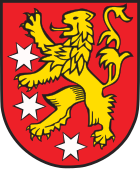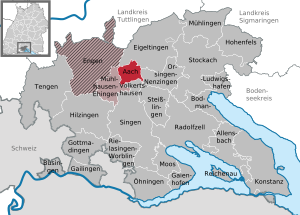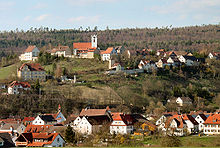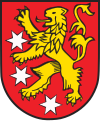Aach (Hegau)
| coat of arms | Germany map | |
|---|---|---|

|
Coordinates: 47 ° 51 ' N , 8 ° 51' E |
|
| Basic data | ||
| State : | Baden-Württemberg | |
| Administrative region : | Freiburg | |
| County : | Constancy | |
| Height : | 545 m above sea level NHN | |
| Area : | 10.68 km 2 | |
| Residents: | 2296 (December 31, 2018) | |
| Population density : | 215 inhabitants per km 2 | |
| Postal code : | 78267 | |
| Area code : | 07774 | |
| License plate : | KN | |
| Community key : | 08 3 35 001 | |
| LOCODE : | DE AAC | |
City administration address : |
Hauptstrasse 16 78267 Aach |
|
| Website : | ||
| Mayor : | Manfred Ossola | |
| Location of the city of Aach in the district of Constance | ||
Aach ( [ aːx ] ) is a small town in the district of Konstanz in Baden-Württemberg in Germany .
No other villages belong to the city of Aach. It is known for the Aachtopf , the strongest spring in Germany.
geography
location
Aach is located in Hegau , a volcanic landscape between Lake Constance and the Swiss canton of Schaffhausen . To the north, behind the Upper Danube, is the Swabian Alb . A few kilometers to the east and south-east are the arms of Lake Constance Überlinger See and Zeller See . The border with Switzerland is about 14 kilometers away in the southeast.
Neighboring communities
The city borders in the north on Eigeltingen , in the east on Orsingen-Nenzingen , in the south on Volkertshausen and in the west on Mühlhausen-Ehingen .
Land use
The following table shows the area survey by type of actual use as of December 31 of the specified year:
| Land use | 1988 | 2000 | 2010 |
|---|---|---|---|
| Agricultural area | 50.7% | 47.9% | 42.6% |
| Forest area | 40.4% | 40.7% | 41.8% |
| Settlement and traffic areas | 7.9% | 10.6% | 13.2% |
| Water surface | 0.7% | 0.6% | 1.1% |
| other types of use | 0.3% | 0.2% | 1.3% |
history
Aach was first mentioned in a document in 1100. At that time, today's urban area belonged to the Duchy of Swabia . The name Oppidum Ach in Hegovia is attested from the year 1150 . The lordship came to the bishopric of Constance around 1200 from the Lords of Aach . Aach was granted town charter in 1283 by King Rudolf I. Aach remained part of Upper Austria for the next few centuries . In 1465 the House of Habsburg bought the Landgraviate of Nellenburg, in which the city was located.
In 1499 was in the region in the Swabian War - between the Swabian League fought for supremacy - and Switzerland.
Only 26 years later, in 1525, Aach was the scene of the German Peasants' War : The Hegau nobility fled from rebellious peasants to the city, after which it was occupied by the rebels. By September of that year, however, the uprisings were suppressed.
On March 25, 1799, battles took place here between the Austrians under Archduke Karl and the French under Jourdan in the coalition wars. After Austria's defeat in the Third Coalition War , Aach first came to Württemberg in 1806, and finally to the Grand Duchy of Baden in 1810 after another change of territory . There the city belonged to the Stockach district for a long time and became part of the Konstanz district during the district reform in 1973 .
Population development
The city of Aach has 2,270 inhabitants. The population growth was particularly strong from 1987 to 2005, the number of inhabitants increased in this period by a total of 61 percent or an annual average of 2.7 percent. Since the end of 2005 the population has remained relatively constant. At 9.7 percent, the proportion of foreigners is below the value for the district of Konstanz (13.9 percent).
Development of the population:

1871–1961, 1970 and 1987: census results; Rest: extrapolation of the population as of December 31, 1961 and 1970: census results; Rest: updates of the population as of December 31 of the year
politics
Municipal council
After the local elections on May 26, 2019 , the following distribution of seats resulted. The turnout was 56.76% (2014: 51.1%). The municipal council consists of the elected voluntary councilors and the mayor as chairman. The mayor is entitled to vote in the municipal council.
| Political party | Share of votes | Seats | 2014 result | |
|---|---|---|---|---|
| CDU | 47.93% | 5 | 40.5%, 4 seats | |
| Free voter association Aach | 41.23% | 4th | 30.0%, 3 seats | |
| Independent Free List Aach | 10.84% | 1 | - | |
| SPD | - | - | 23.8%, 2 seats | |
| FDP | - | - | 5.6%, 1 seat |
mayor
The Mayor of Aach is a full-time civil servant. The first term of office of Severin Graf, who was re-elected in 2009, began on December 6, 2001. Severin Graf's term of office ended on December 5, 2017. At the mayoral election on September 24, 2017, the only candidate Manfred Ossola received 97.42% of the votes cast, with a turnout of 70.4%. His inauguration was at the public council meeting on December 6, 2017.
Administrative community
Like Mühlhausen-Ehingen, the city belongs to the agreed administrative community of the city of Engen.
coat of arms
| Blazon : "In red a golden (yellow) lion with three silver (white) stars spread between the paws." | |
| Reasons for the coat of arms: The lion can be used as an indication of belonging to Habsburg. The stars were used to distinguish it from the ruler's coat of arms. |
Town twinning
Aach's twin town is Klingenberg (Saxony) . Initially, this partnership was concluded with the former municipality of Colmnitz , which is now a district of Klingenberg, which has taken over the partnership.
Attractions
See also: Complete city of Aach
Buildings
- The so-called Old Town Hall in Stadtstrasse 38 was named “ Monument of the Month November 2008” by the Baden-Württemberg Monument Foundation.
- On the outskirts of the city lies the Alter Turm Aach castle ruins , which are the remains of a castle from the 11th century .
Natural monuments
The Aachtopf , the strongest spring in Germany, is located in the urban area of Aach . The Aachtopf is the source of the Radolfzeller Aach, which flows into Lake Constance . It is fed by the water of the Danube , which seeps to the north about twelve kilometers (as the crow flies ) from the source of the Aach between Immendingen and Fridingen in the karst limestone of the White Jura ( Danube seepage ) and here with an average of 8,300 l / s (minimum 1,300 l / s) s, maximum 24,100 l / s) discharge leaks.
Economy and Infrastructure
Companies
Various businesses are located in the city of Aach, most of them in an intermunicipal business park with the Volkertshausen community .
education
In Aach there is a public elementary school with 91 students. The public secondary school was closed in the summer of 2010 after only 13 students attended this school in the last school year. There is also a kindergarten in Aach .
traffic
The nearest train station is five kilometers away in Mühlhausen-Ehingen . There are connections to long-distance trains from Singen, twelve kilometers away, or from the train station in Engen, six kilometers away .
Bus connections go to Singen, Stockach and in the direction of Engen.
Aach is not far from the Hegau motorway junction . There are fast connections in all directions via the federal highway 81 , the federal highway 98 and the two-lane federal highway 33 . The city is also on the federal highway 31 ( Freiburg im Breisgau - Friedrichshafen ).
Personalities
- Otto Trippel (1891–1954), documentary filmmaker
- Andreas Mettler (* 1968), game developer and game designer, place of birth
- Thomas Rid (* 1975), political scientist and non-fiction author
Others
Aach comes first in the alphabetical listing of all German cities .
Web links
Individual evidence
- ↑ State Statistical Office Baden-Württemberg - Population by nationality and gender on December 31, 2018 (CSV file) ( help on this ).
- ↑ Baden-Württemberg State Statistical Office: Structural and regional database , accessed on February 12, 2012.
- ↑ Heinrich Gottfried Gengler: Regesta and documents on the constitutional and legal history of German cities in the Middle Ages , Erlangen 1863, page 1
- ↑ State Statistical Office Baden-Württemberg: Structural and regional database , accessed on June 12, 2018.
- ^ Website of the city of Aach - partner municipality Colmnitz , accessed on October 1, 2019








